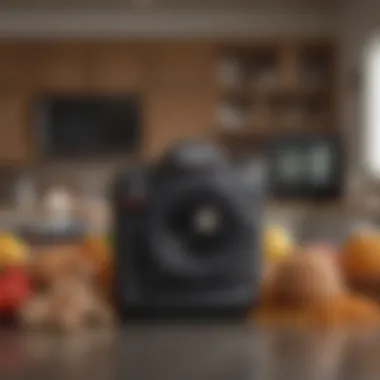Ruggable Competitors: A Deep Dive into Home Textiles


Intro
In the home textile market, Ruggable stands as a noteworthy influencer, particularly known for its innovatively designed washable rugs. However, the presence of various competition adds depth to the market space and shapes consumer choice. Understanding the competitive landscape is imperative for anyone considering a purchase, whether for aesthetic or functional needs.
An exploration of Ruggable's key competitors reveals not only the strengths and strategies employed by these brands, but also prevailing trends that influence buyer behavior. Consumers may seek alternatives based on product offerings, pricing and overall satisfaction. A deeper look at competitors such as Flor, Annie Selke, and Peace Industry highlights how these brands fare against Ruggable in aspects such as material quality, available designs, and practices toward sustainability.
The home textile industry is vast, and navigating its complexities requires a critical eye. This article will serve as a comprehensive guide—dismantling competitor strategies while offering insights useful for informed purchase decisions. Each section will consider various facets of the market, aiming to synthesize the information presented for clarity and thorough understanding.
Competitive Landscape Analysis
Identifying the competitors in the home textile sphere is crucial. Ruggable's main rivals each own distinct market niches that cater to different demographics and needs. Careful analysis allows one to assess their distinct positioning relative to Ruggable.
Key Competitors
Among the contenders are brands like Flor, which specializes in modular carpet tiles, and Annie Selke, known for luxurious fabrics. Each brand leverages unique elements that set them apart in the realm of home textiles, often centering around quality, innovation and customer satisfaction.
- Flor: Modular designs and customizable options.
- Annie Selke: High-end aesthetics focused on textures and colors.
- Peace Industry: Sustainable and artistic offerings utilizing traditional craft.
The strengths of these brands each resonate with differing consumer values. Regardless of personal prefer.014
Strategies and Market Trends
Overall market trends indicate an inclination towards sustainability in home goods, with consumers actively seeking brands that align with greener practices. Companies like Peace Industry have built substantial brand identity by integrating eco-friendly materials in their supply chains. Pricing structures also play a large role in ongoing market behavior, with analysis showcasing divergent approaches among competitors.
Understanding these strategies provides insight into effective buying behaviors. Being informed can illuminate preferences beyond baseline characteristics such as aesthetic arrangements and product durability. As choices progress beyond mere aesthetics, discerning customers now seek deeper value propositions through their textile investments.
Price Assessment and Customer Satisfaction
When evaluating Ruggable and its competition, price sensitivity emerges as a considerable influence on customer perception. The positioning of product prices drastically affects brand loyalty and purchase frequency. Ruggable evokes interest through functionality, yet competitors like Annie Selke may attract buyers through prestigious branding. Engaging with customer feedback allows us to discover overall satisfaction beyond buying motivations, showcasing how differing qualities lead to varied experiences in using home textiles.
Today’s consumers eagerly seek authenticity, with reviews elucidating what buyers prioritize when choosing their home textile items. As results show high levels of engagement, it’s notable that factors such as product lifespan and ongoing aesthetics reaffirm purchasing decisions in the workspace or domestic environments.
Sustainability Practices
An undercurrent throughout brand evaluations is the sustainability practices that come into play in today’s market. More customers are educated on the ecological impacts of their choices and thus prefer companies like Peace Industry that meld product quality with ethical manufacturing stories. Indications indicate that such commitments could sway opinions greatly in favor of brands who prioritize this dimension. Closed-loop production and post-consumer waste are beginning to stand out elements that consumers unlikely overlook.
Through this narrative, aspiring buyers will navigate understanding key variables faced when comparing competitors to Ruggable. Given these factors—functionality, sustainability, aesthetic diversity—the choice to pursue home textiles becomes clearer. Seeking final resolution path utilizes real insight, connecting buyers to products geared toward enhancing their living experiences. The upcoming sections will dissect product specifics further and accentuate potential decision influencers worth considering amid this lucrative market.
Understanding the Home Textile Market
Understanding the home textile market serves as a foundational element in analyzing Ruggable's competitors. The market is complex and widely varied, comprised of many players each with their unique strengths and weaknesses. Grasping the dynamics at play in this sector is crucial for comprehending how companies compete, innovate, and cater to consumer preferences.
As consumers increasingly prioritize comfort and aesthetics in their living spaces, home textiles have become a focal point in interior design. This shift is primarily attributed to the rise in remote work and an increased focus on home renovations. Beyond style, there's also growing concern for sustainability. Therefore, understanding the market encompasses evaluating material quality, design trends, and consumer behavior.
AWS]oftening the details, the assessment of competition should include price aspects, geographical influence, and marketing strategies. Ultimately, a thorough comprehension of the home textile market influences not just consumers making choices but also investors and industry insiders who seek to position themselves competitively within a rapidly changing environment.
Market Overview
The home textile market has shown continual growth each year, largely assisted by advancements in design and technology. Major categories include bedding, curtains, upholstery, and carpets. As each category evolves, there are shifting preferences that reflect larger social trends.
In a practical sense, this market has been bolstered by online sales gains as more consumers take to eCommerce for procurement. The digital shift if fortified forward-thinking branding alongside tailored marketing and outreach, creating opportunities for smaller brands to enter the space and enhancing challenge for established parties.
Understanding consumer expectations directly contributes to shaping market strategies.


The demand for eco-friendly products has notably increased, placing pressure on traditional fabric sources and manufacturing processes. This potential market evolution fastens companies inclusion of sustainable practices, impacting materials choices and cost structures. Regularly assessing industry changes guarantees that brands remain relevant.
Key Players in the Industry
The home textile industry features an array of established names with robust market shares and significant brand loyalty. Players such as Bed Bath & Beyond, IKEA, and Target are focal due to the fact they have horizontally expanded their product scope beyond basics. Furthermore, brands like Pottery Barn and Crate & Barrel have risen in esteem, tethering premium offerings to their market presence.
In addition to big-box retailers, numerous direct-to-consumer brands are gaining visibility in niche markets. Companies such as Ruggable and Blanket provide focused product selections tailored to modern consumer demands. Factors driving these advancements include innovative product designs that blend style with practical ease.
And increasing number of players entering the industry reflects an exciting reality of diverse product offerings and investment in sustainability. As consumer tastes evolve, future entrants will likely continue to jostle with well-known names while navigating ever-changing market challenges within the home textiles sphere.
Preface to Ruggable
Understanding Ruggable is crucial in comprehending the landscape of the home textile market. As an influential player, it sets industry benchmarks in design, innovation, and sustainability. The exploration of Ruggable's business model offers key insights into its competitive strengths, particularly its technology-driven approach to product offerings and marketing.
Company Background
Ruggable was founded with a simple but powerful idea: making stylish rugs that people can easily clean. The brand utilizes a patented two-piece rug system that allows for easy removal and cleaning. This revolutionary concept not only offers convenience but also maintains aesthetic appeal. Ruggable started gaining traction around 2017, capitalizing on the rising trend of home personalization and cleanliness. Its receptiveness to market needs reflects a keen understanding of consumer behavior. This adaptability has positioned Ruggable as a standout entity in the home textile sector.
Product Offerings
Ruggable's product lineup is robust and innovative. The brand offers a variety of rugs with distinct patterns, colors, and sizes, all designed to appeal to different segments of consumers. Here are some notable features of their product offerings:
- Stylish Designs: Ruggable presents an extensive selection, from bohemian to modern styles.
- Materials: Most rugs are made of quality polyester that is safe and comfortable underfoot.
- Washable Rugs: The ability to remove the top layer and machine-wash is a significant selling point.
- Compliance with Safety Standards: Behind its attractive designs, Ruggable ensures all products meet safety and health standards for household textiles.
Overall, Ruggable's unique product combination of style and functionality addresses a critical consumer need. As clean homes become a priority, Ruggable remains a key player in influencing consumer choices in the home textile market.
Identifying Ruggable's Competitors
Identifying Ruggable's competitors in the home textile market is essential for understanding how this company positions itself against others and how it can improve its offerings. By recognizing both major and emerging players in the market, consumers can make informed decisions and brands can better strategize their marketing and product development efforts. This section highlights the unique aspects of Ruggable's competitors and places emphasis on product diversity, innovation, and customer response.
Overview of Major Competitors
The major competitors of Ruggable include established brands that have been in the home textile industry for years. Companies like NuLoom, Safavieh, and Mohawk Home offer a variety of rugs and textiles that rival Ruggable’s washable options. These brands provide traditional carpet solutions as well as modern designs, catering to both classic and contemporary tastes.
- NuLoom: Known for its unique designs, it features an extensive collection suitable for various decor styles.
- Safavieh: Combines quality and classic designs, boasting a wide array of luxury area rugs.
- Mohawk Home: Focuses on innovative materials, highlighted by their eco-friendly product line, along with affordable pricing options.
Each of these competitors has carved out their niche but also adheres to the standards of product quality and style that consumers expect. They invest heavily in marketing and have established a strong online presence to extend their reach in the market.
Emerging Competitors
In addition to these major players, the rise of small or newer brands adds a fresh perspective to the competition. Brands like Ruggable face infiltration from companies such as Kaymu and Earth Weave. These emerging competitors are leveraging the current trend toward sustainability and customization.
- Kaymu: This brand offers personalized rugs, allowing consumers to design according to their style preferences. They appeal notably to younger, environmentally conscious buyers.
- Earth Weave: Focuses on organic and natural materials, claiming proper biodegradability in their products. Thier marketing emphasizes recycled resources and its usefulness.
Emerging brands challenge not just through their unique products but also via social media strategies, gaining traction among eco-conscious consumers quickly.
Ruggable must remain informed and adaptive to these changes. They should observe customer behaviors towards these competitor options to understand where their advantage lies and how they can reinforce their market position.
Comparative Analysis of Competitors
Understanding the competitive landscape is pertinent in today’s home textile market. A Comparative Analysis of Competitors allows stakeholders and consumers to comprehend how Ruggable stands in relation to its peers. It explores multiple factors, including product quality, design, and price—critical elements affecting the purchasing decisions of consumers.
This and independent evaluations highlight specific strengths and weaknesses among brands. It helps identify differentiating factors that may sway consumer preferences. Ultimately, analyzing these variables can present significant insights for brands aiming to improve their offerings.
Product Quality Assessment


In the home textile sector, product quality serves as a benchmark of both brand durability and consumer satisfaction. It encompasses material composition, finishing, and functional characteristics of products available in the market among Ruggable's competitors. Brands that focus on high-quality materials, such as well-finished fabrics or innovative layering technologies tend to capture a more discerning audience.
When assessing competitors, it is indispensable to explore:
- Material Durability: Textile longevity profoundly impacts repeat purchases.
- Maintenance Ease: Consumers favor products that maintain aesthetics with minimal efforts.
- Performance Features: Water-resistance and stain-resistant properties add immense practical value to home textiles.
Assessing quality concerns should focus on practical examples, such as unique features that differentiate latex vs polyurethane backing materials used by competing brands.
Design and Aesthetic Comparisons
The design of home textiles plays a fundamental role in enhancing decorative themes within living spaces. In the case of competitors to Ruggable, each brand presents varying patterns, colors, and styles that cater to diverse consumer tastes. Attention to trending designs and innovative aesthetics is essential in evaluating market posture.
Key aspects to explore in design comparison include:
- Variety of Styles: Competitors can offer contemporary, vintage, and eclectic designs.
- Customization Options: Choices in personalization have increased consumer appeal significantly.
- Influence of Seasonal Trends: Brands that adapt their designs regularly may keep consumers engaged longer, making it necessary to analyze seasonal collections.
Understanding what attracts customers can shed light on successful design strategies employed by Ruggable and its rivals.
Price Point Differences
In comparing competitors, price point technology and pricing strategies emerge as critical elements impacting consumer choices. With rising consumer price awareness, products within the same functional category tend to compete at differentiated levels based on perceived value and affordability.
Factors affecting price comparison include:
- Brand Reputation: Established brands can often command a market premium.
- Economical Options: New entrants may lure price-sensitive consumers with strategic pricing offers.
- Membership and Discounts: Promotions or warranties also shape consumer perspectives toward price-associated value.
A clear understanding of these price fluctuations enhances decision-making abilities for consumers aimed at maximizing value in their purchase.
Informed comparative analyses can guide consumers through various facets of the decision-making process while providing manufacturers insightful strategies for growth.
Customer Satisfaction Insights
Understanding customer satisfaction is key in evaluating Ruggable's position within the home textile market. Identifying how consumers perceive products can inform brands on areas that need improvement or highlight strengths worthy of promotion. The insights gained can help businesses tailor their marketing strategies to match consumer expectations.
Review and Rating Analysis
When customers purchase a product, they often rely on reviews to guide their decisions. This can be especially true in the home textile segment, where tactile qualities and aesthetics weigh heavily in final choices. Online retail platforms such as Amazon and Wayfair usually provide broader pools of reviews and ratings. Customers generally share experiences relating to quality, durability, and easy maintenance. Not infrequently, consumers praise or criticize brands based on these factors:
- Quality Durability: Sustained quality over time tends to enhance brand loyalty.
- Ease of Cleaning: Users appreciate low grooming needs, advantageous in busy households.
- Aesthetic Appeal: Visuals matter. Unique design offerings can garner positive reactions general.
The overall ratings from sources can also help in forming an accepted hierarchy of brands and can outline Ruggable's place within this landscape.
Customer Feedback Trends
Examining consumer feedback trends reveals how the home textile market is evolving. Social media platforms like Facebook and specialized forums like Reddit are also vital in shaping public consciousness around these products. Trends indicate that consumers often juxtapose the satisfaction derived from purchase experiences with expectations established by previous generations. Factors relevant to current considerations may include:
- Eco-Friendly Preferences: Consumers today are inclined towards ecological buying practices. Brands utilizing sustainable materials frequently draw recognition.
- Functionality and Versatility: Home textile buyers seem to respond favorably to items offering aesthetic flexibility, catering to diverse tastes but keeping functional use in mind.
- Customer Service: Retaining care through reliable customer service generates strength in brand loyalty.
Feedback often communicates intentions for repurchase and recommendations to peers. Within this competitive landscape, listening and responding to consumer sentiment is vital for Ruggable and its competitors.
Sustainability Practices among Competitors
Sustainability has become a crucial factor in the home textile market. It shapes how consumers and brands interact, focusing not only on profit but also on planetary and social well-being. In this article, examining sustainability practices of Ruggable's competitors brings insights into their operations and ethical commitment, which can guide consumers in making responsible choices.


Eco-Friendly Initiatives
Many competitors are adopting eco-friendly initiatives to reduce their carbon footprint and positively impact the environment. This often includes the use of organic materials, sustainable manufacturing processes, and thoughtful waste management tactics. Brands like Merrilees and Brooklinen highlight their use of recycled and organic materials, which not only minimizes waste but ensures better air quality and safety for users. Implementing these initiatives pushes competitors to lead sustainably while providing a better product.
Additionally, many companies engage in fair labor practices, ensuring workers' rights are respected. Implementing responsible sourcing guidelines can make brands more appealing to socially-conscious consumers. This transparency builds trust and loyalty among customers, knowing their purchasing decisions both support a good cause and promote healthier materials in their homes.
Material Sourcing Strategies
Material sourcing is a vital aspect of sustainability in home textiles. Competitors have adopted several strategies that highlight their commitment to environmentally friendly practices. Brands often share information about how and where they source fibrous materials. Using organic cotton, linen, or bamboo signifies a lower environmental impact.
Further practices include acquiring materials from certified environmentally sustainable farms. This reduces the ecological impact of textile production, supporting community well-being. Competitors should consider broader aspects; it is also about ensuring durability and longevity of products. Sourcing materials responsibly affects the quality of the final product while contributing to a more sustainable lifecycle. Competitive brands that showcase transparency in sourcing are likely to meet consumer demands for ethical products more effectively.
Sustainability practices reflect a brand's values, making them instrumental in capturing a discerning audience. Engagement with eco-friendly initiatives and responsible sourcing goes beyond trends; they resonate profoundly with today's informed consumer.
Trends Impacting Consumer Choices
In today's market, understanding the habits and preferences of consumers is crucial. This is especially valid in the home textile sector where brands like Ruggable face new challenges daily. Trends impacting consumer choices not only affect what products are purchased, but they also shape brand perception.
Manufacturers must pay attention to these trends. Ignoring them can lead to missed opportunities or product failures. Thus, tracking consumer sentiment through various means, such as market research and social media discussions, holds significant relevance.
Shift Towards Eco-Conscious Products
Recently, there has been a marked shift towards eco-conscious products. Consumers increasingly prefer items sourced sustainably and produced with minimal harm to the environment. As a result, brands are refreshing their entire line of products to either to meet this demand or risk being left behind.
Benefits of Eco-Friendly Choices
- Lower Environmental Impact: Using sustainable materials generally results in reduced pollution as well as conservation of natural resources.
- Improved Brand Loyalty: Adopting eco-friendly practices tends to resonate positively with current and potential customers. People want to support businesses that align with their values.
- Health Consciousness: Many consumers believe that environmentally friendly products are safer. They express concerns about harmful chemicals associated with traditional textiles, the so-called off-gassing issues particularly in carpets.
The market is reacting; numerous competitors to Ruggable are pivoting their product lines. For instance, brands are now considering organic cotton, recycled fabrics, and sustainable dyes as their primary materials. Recognizing this trend has become pivotal for anyone aiming for long-term success.
Influence of Online Shopping
Another key trend significantly affecting consumer behavior is the rising influence of online shopping. E-commerce has transformed the retail landscape, facilitating ease of purchase for consumers.
Impact of Online Shopping on Consumer Decisions
- Convenience: Shoppers appreciate the ability to browse unordered choices from their homes at any time.
- Price Comparisons: Online platforms make it simple to compare prices and read reviews before making choices.
- Abundance of Options: The sheer diversity of brands and designs enables consumers to feel absorbed in exploring multiple selections that best fit their styles and budgets.
Companies that do not harness the mechanics of online shopping can struggle. Learning to optimize their digital presence can affect not just visibility, but directly influence sales metrics.
In summary, staying ahead in home textiles means adapting to eco-conscious practices and embracing the online retail evolution. Companies including Ruggable need to integrate both factors for lasting success.
Culmination and Future Outlook
The significance of this section lies in its capability to encapsulate the insights gained throughout the article. This enables readers to quickly understand how Ruggable competes in the rapidly evolving home textile market. In the competitive landscape, analyzing formidable competitors helps consumers and industry stakeholders comprehend product offerings while making informed decisions.
We have examined the remarkable features and strategies competitors utilize. Key aspects, such as market responsiveness, innovation in design, and varying pricing strategies were benchmarked against Ruggable. Through a nuanced exploration of customer satisfaction, material sourcing, and sustainability practices among leading brands, this analysis provides a robust guide for current and prospective consumers in the home textile domain.
Summary of Findings
The analysis has underlined several pertinent findings. Firstly, Ruggable’s product innovation, particularly in washable rugs, places it at an advantage against competitors who favor traditional frameworks. Gaps in service offerings reflect consumers’ desires; for instance, many are leaning towards brands that offer eco-friendly products.
- Product Diversity: Ruggable maintains an expansive range of styles, appealing to various aesthetics distinctly. This contrasts with some competitors who specialize in limited offerings.
- Sustainability Focus: Brands prioritizing eco-conscious strategies have begun to carve a significant niche in consumer preferences, influenced heavily by millennial and Gen Z shoppers.
- Pricing Advantages: Competitive pricing, combined with promotions around new launches, appears to sway potential buyers. Ruggable’s transparency in pricing is notable against competitors’ often opaque strategies.
Predictions for Market Trends
Looking ahead, it is feasible to chart certain market trends that could reshape the home textile industry. Shift towards greater sustainability will amplify, with demands for eco-friendly materials set to intermittentibly rise. Competitors are likely to adjust their product lines significantly—increase featuring natural fibers and recycled materials.
- Innovation in Fabrics: Advances in fabric technology will likely enable more brands to develop textiles that prioritizes functionality without surrendering design appeal.
- Increased Online Engagement: The influence of e-commerce remains crucial. Retailers championing digital platforms with seamless user experiences may seize elevated market shares.
- Consumer Education: As customers become better informed, there will be a greater inclination towards brands prioritizing transparency in sourcing and production ethics.
In summary, the ever-increasing gravitation towards sustainability, combined with technological developments, will forge the future landscape of the home textile industry. Companies that attune to such consumer expectations will likely remain relevant, while others could face sizable challenges.







